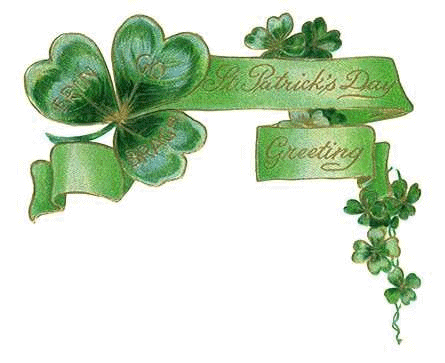
Irish Immigrant

True history and legend are intertwined when it comes to St. Patrick. It is known that he was born in Scotland and was kidnapped and sold in Ireland as a slave. He became fluent in the Irish language before making his escape to the continent. Eventually he was ordained as a deacon, then priest and finally as a bishop. Pope Celestine then sent him back to Ireland to preach the gospel. Evidently he was a great traveller, especially in Celtic countries, as innumerable places in Brittany, Cornwall, Wales, Scotland and Ireland are named after him.
Here it is where actual history and legend become difficult to seperate.
Patrick is most known the world over for having driven the snakes from Ireland. Different tales tell of his standing upon a hill, using a wooden staff to drive the serpents into the sea, banishing them forever from the shores of Ireland. One legend says that one old serpent resisted, but the saint overcame it by cunning. He is said to have made a box and invited the reptile to enter. The snake insisted the box was too small and the discussion became very heated. Finally the snake entered the box to prove he was right, whereupon St Patrick slammed the lid and cast the box into the sea. While it is true there are no snakes in Ireland, chances are that there never have been since the time the island was seperated from the rest of the continent at the end of the ice age. As in many old pagan religions serpent symbols were common, and possibly even worshipped. Driving the snakes from Ireland was probably symbolic of putting an end to that pagan practice.
While not the first to bring Christianity to Ireland, it was Patrick who encountered the Druids at Tara and abolished their pagan rights. He converted the warrior chiefs and princes, baptizing them and thousands of their subjects in the Holy Wells which still bear that name. According to tradition St. Patrick died in A.D. 493 and was buried in the same grave as St. Bridget and St. Columba, at Downpatrick, County Down. The jawbone of St. Patrick was preserved in a silver shrine and was often requested in times of childbirth, epileptic fits and as a preservative against the evil eye. Another legend says St. Patrick ended his days at Glastonbury and was buried there. The Chapel of St. Patrick still exists as part of Galstonbury Abbey. There is evidence of an Irish pilgrimage to his tomb during the reign of the Saxon King Ine in A.D. 688, when a group of pilgrims headed by St. Indractus were murdered.
The great anxiety displayed in the middle ages to possess the bodies, or at least the relics of saints, accounts for the many discrepant traditions as to the burial places of St. Patrick and others. And St. Patrick and the shamrock?

'Twas Saint Patrick himself sure that set it
And the sun on his labor with pleasure did smile
And a tear from his eyes oft-times wet it
It grows through the bog, through the brake, through the mireland
And they call it the dear little Shamrock of Ireland
(Irish Blessing)
The Shamrock, at one time called the "Seamroy", symbolises the cross and blessed trinity. Before the Christian era it was a sacred plant of the Druids of Ireland because its leaves formed a triad. The well known legend of the Shamrock connects it definitely to St. Patrick and his teaching. Preaching in the open air on the doctrine of the trinity, he is said to have illustrated the existence of the Three in One by plucking a shamrock from the grass growing at his feet and showing it to his congregation.
The legend of the shamrock is also connected with that of the banishment of the serpent tribe from Ireland by a tradition that snakes are never seen on trefoil and that it is a remedy against the stings of snakes and scorpions. The trefoil in Arabia is called shamrakh and was sacred in Iran as an emblem of the Persian triads. The trefoil, as noted above, being a sacred plant among the Druids, and three being a mystical number in the Celtic religion as well as all others, it is probable that St. Patrick must have been aware of the significance of his illustration.

May the wind be always at your back,
May the sun shine warm upon your face,
The rains fall soft upon your fields and,
Until we meet again,
May God hold you in the palm of His hand


Our Adopted Leprechaun from


 This Adopt a Leprechaun Webring site
This Adopt a Leprechaun Webring site
is owned by The Scott Family.
Want to join the
Adopt a Leprechaun Webring?
[Skip Prev]
[Prev]
[Next]
[Skip Next]
[Random]
[Next 5]
[List Sites]
Adopt a Leprechaun Webring?


 CONTENTS
CONTENTS